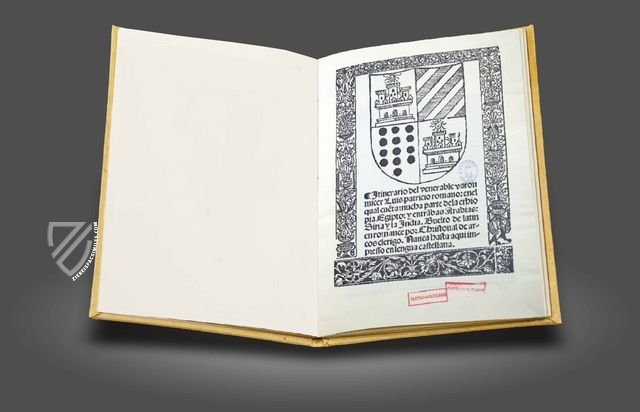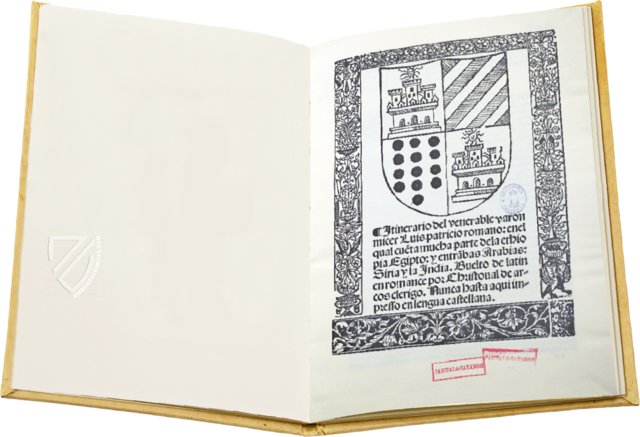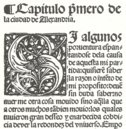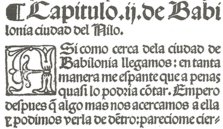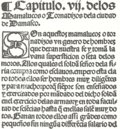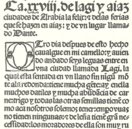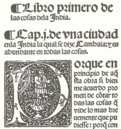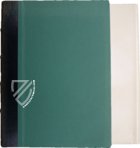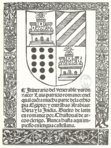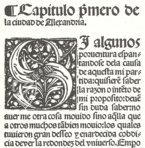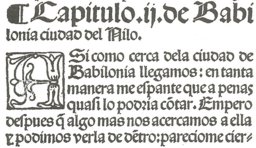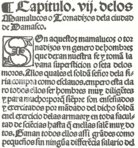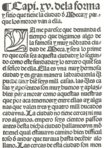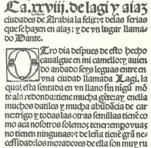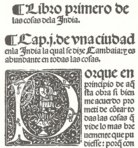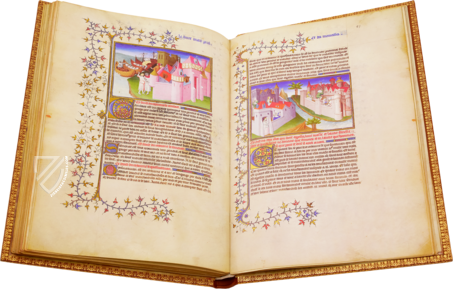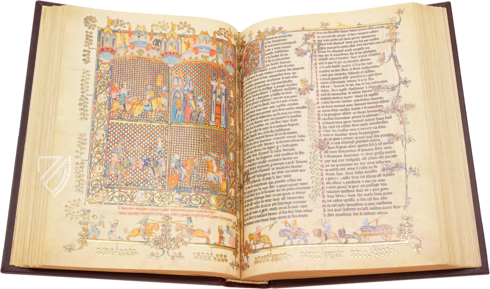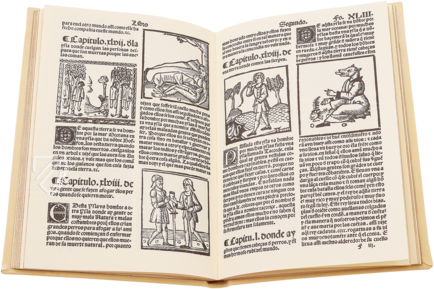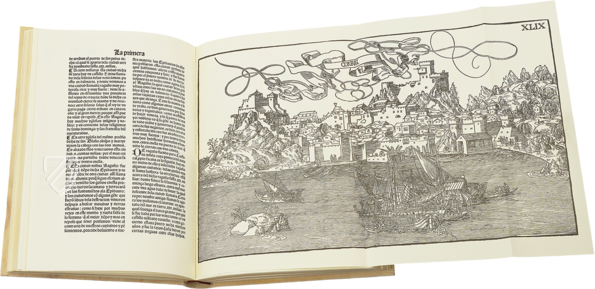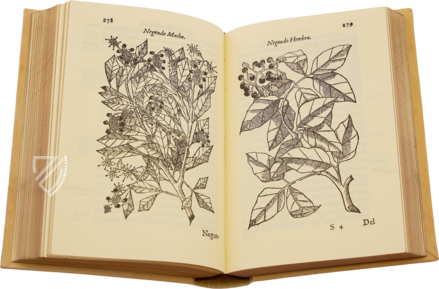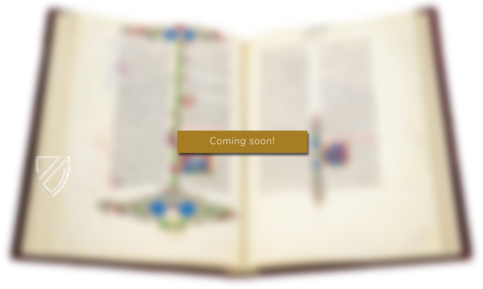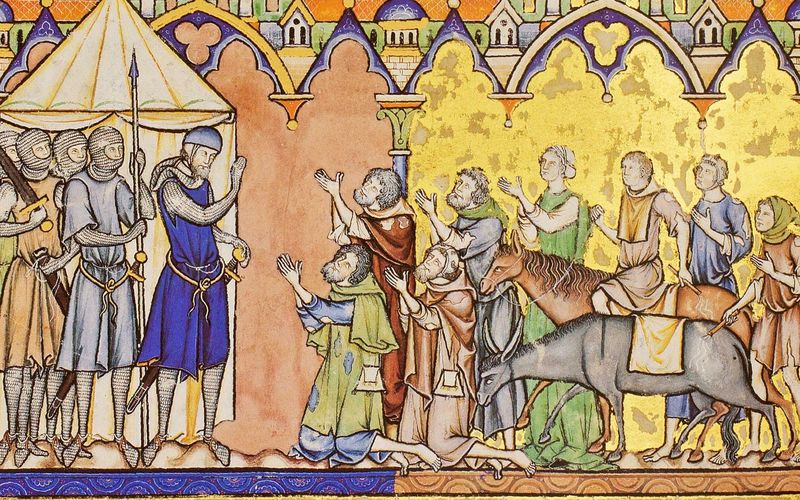Itinerary of Ludovico di Varthema
(under 1,000€)
This famous 16th century travelogue was written by the Italian nobleman Ludovico di Varthema, who is also cited as Barthema, the first non-Muslim visitor to Mecca who also travelled as far as Indonesia. His writings are the oldest European impressions of South Asia and enjoyed widespread circulation during his life and after his death. It serves as a precious testament to the spirit of the Age of Exploration and the European fascination with the exotic. The Spanish translation of the work was executed by Cristóbal de Arcos, who was also responsible for other notable translations including the works of Jacome Fontano and Agostino Nifo. Richard Francis Burton said in his book The Pilgrimage to Al-Medinah and Meccah: “For correctness of observation and readiness of wit Varthema stands in the foremost rank of the old Oriental travelers. In Arabia and in the Indian archipelago east of Java he is (for Europe and Christendom) a real discoverer. Even where passing over ground traversed by earlier European explorers, his keen intelligence frequently adds valuable original notes on peoples, manners, customs, laws, religions, products, trade, methods of war.”
Itinerary of Ludovico di Varthema
This important 16th century travelogue was written by Ludovico di Varthema (ca. 1470–1517), an Italian aristocrat from Bologna made a name for himself as a traveler, diarist, and the first non-Muslim European to visit Mecca. He set out from Venice in 1502 on a grand adventure travelling through the Middle East, eventually taking him as far as India, Southeast Asia, and Indonesia before returning to Europe in 1507, dying ten years later in Rome. His travelogue was originally published in Rome in 1510, the edition at hand was published in Seville in 1520 by Jacobo Cromberger (ca. 1472–1528) and was translated into Spanish by Cristóbal de Arcos, chaplain to Diego de Deza (1444–1523), Archbishop of Seville. It represents the oldest surviving testimonial regarding many of these regions.
Inspired by Antiquity
Virtually all that is known about the life of the author comes from his own writings and it is believed that he was a soldier with a sense of adventure who left Europe in 1502. Varthema gives the following explanation for his ambitious journey: “moved with zeal and love to see with the eyes: what he sometimes read in Ptolemy, Strabo, Pliny, and others who wrote about cosmography and geography: he determined to entrust his soul to God: and the body to the works and variety of fortune: and to go around most of Asia and Africa: only those things he wished to see that were hidden from us.” Fascination with the exotic gripped the Late Middle Ages and travelogues both real and fantastic were extremely popular. As such, Varthema is a perfect reflection of the Zeitgeist of the Age of Exploration.
Sneaking into the Holy Cities of Islam
The author’s exotic adventure into the East began when he arrived in Alexandria in early 1503 before making his way up the Nile. He left Egypt and sailed for Beirut and then visited Tripoli, Aleppo, and Damascus, where he supposedly enrolled himself in the Mamluk garrison under the name Yunus or “Jonah”. Posing as a Mamluk escort of a caravan of pilgrims participating in the Hajj and it was in this guise that he became one of the first non-Muslim Europeans to see the sacred cities of Mecca and Medina. The accuracy with which he describes the cities as well as the chief pilgrimage sites and ceremonies confirm his story.
The Journey to Asia
On his way to India, Varthema was imprisoned in Aden and freed by becoming the lover of a sultana of Yemen before coming to Persia and reuniting with the merchant he met in Mecca. “Cazazioner” is his travel companion throughout Asia and they first sail to India, reaching the mouth of the Indus River by 1504. They travel extensively and explore both the coasts and much of the interior of India before travelling through the Bay of Bengal from Caylon to Burma, where he claims to have met a pair of Christian Chinese merchants. After crossing the Strait of Malacca, the four of them proceeded to Sumatra, where Varthema describes plentiful spices and perfume plants, which inspired them to visit the famous Spice Islands. Again, Varthema may have been the first European to ever visit the Moluccas and writes extensively about the spices, their cultivation, and their prices.
Return to Europe
Varthema and Cazazioner began the return journey West via Borneo and Java before returning to Calcutta, where they encountered two Italian military engineers hired by the local ruler to cast European-style canons to counter the incursions of the Portuguese. After revealing himself to his compatriots as a Christian and an Italian, they in turn revealed that they were being held against their will. Knowing that a Portuguese fleet was expected to arrive in September of 1505, Varthema came up with a plan to get them home with the help of a letter of introduction from his old Persian friend whom he would never see again.
After coming to Cannanore, where the Portuguese fleet was anchored, with a group of Persian merchants, he managed to slip away from them and met with the commander Lourenço de Almeida (ca. 1480–1508). He shared his observations of Calcutta’s defenses in exchange for help, although the two Italian military engineers were killed by a mob before they could be rescued. There he remained for a year and a half in service of the Portuguese and witnessed the Battle of Cannanore, which he describes in detail, endured the 1507 Siege of Cannanore, and participated in a punitive raid on Ponnani in November of that year.
He departed for Europe on the 6th of December 1507, sailing around Africa, of which Varthema gives numerous accounts, some of which appear to be second-hand. After he reached Lisbon in the spring of 1508, he received a confirmation of the knighthood that was granted to him in India, and then travelled to Rome where the travelogue ends and where Verthema spent the rest of his life.
Codicology
- Alternative Titles
- Itinerario del Venerable Varon Micer Luis Patricio Romano, en el qual cuenta mucha parte de la Ethiopia, Egipto y entrambas Arabias, Siria y la India
Der Weg des Ludovico di Varthema - Size / Format
- 120 pages / 30.0 × 21.5 cm
- Origin
- Spain
- Date
- 1520
- Epochs
- Style
- Language
- Illustrations
- Coat of arms on the frontispiece and engraved initials
- Content
- Varthema's travelogue from Venice to Africa and Asia
- Artist / School
- Ludovico Varthema (author)
Cristóbal de Arcos (translator)
Jacobo Cromberger (printer)
#1 Itinerario del Venerable Varon Micer Luis Patricio Romano, en el qual cuenta mucha parte de la Ethiopia, Egipto y entrambas Arabias, Siria y la India
Language: Spanish
(under 1,000€)
- Treatises / Secular Books
- Apocalypses / Beatus
- Astronomy / Astrology
- Bestiaries
- Bibles / Gospels
- Chronicles / History / Law
- Geography / Maps
- Saints' Lives
- Islam / Oriental
- Judaism / Hebrew
- Single Leaf Collections
- Leonardo da Vinci
- Literature / Poetry
- Liturgical Manuscripts
- Medicine / Botany / Alchemy
- Music
- Mythology / Prophecies
- Psalters
- Other Religious Books
- Games / Hunting
- Private Devotion Books
- Other Genres
- Afghanistan
- Armenia
- Austria
- Belgium
- Belize
- Bosnia and Herzegovina
- China
- Colombia
- Costa Rica
- Croatia
- Cyprus
- Czech Republic
- Denmark
- Egypt
- El Salvador
- Ethiopia
- France
- Germany
- Greece
- Guatemala
- Honduras
- Hungary
- India
- Iran
- Iraq
- Israel
- Italy
- Japan
- Jordan
- Kazakhstan
- Kyrgyzstan
- Lebanon
- Liechtenstein
- Luxembourg
- Mexico
- Morocco
- Netherlands
- Palestine
- Panama
- Peru
- Poland
- Portugal
- Romania
- Russia
- Serbia
- Spain
- Sri Lanka
- Sweden
- Switzerland
- Syria
- Tajikistan
- Turkey
- Turkmenistan
- Ukraine
- United Kingdom
- United States
- Uzbekistan
- Vatican City
- A. Oosthoek, van Holkema & Warendorf
- Aboca Museum
- Ajuntament de Valencia
- Akademie Verlag
- Akademische Druck- u. Verlagsanstalt (ADEVA)
- Aldo Ausilio Editore - Bottega d’Erasmo
- Alecto Historical Editions
- Alkuin Verlag
- Almqvist & Wiksell
- Amilcare Pizzi
- Andreas & Andreas Verlagsbuchhandlung
- Archa 90
- Archiv Verlag
- Archivi Edizioni
- Arnold Verlag
- ARS
- Ars Magna
- ArtCodex
- AyN Ediciones
- Azimuth Editions
- Badenia Verlag
- Bärenreiter-Verlag
- Belser Verlag
- Belser Verlag / WK Wertkontor
- Benziger Verlag
- Bernardinum Wydawnictwo
- BiblioGemma
- Biblioteca Apostolica Vaticana (Vaticanstadt, Vaticanstadt)
- Bibliotheca Palatina Faksimile Verlag
- Bibliotheca Rara
- Boydell & Brewer
- Bramante Edizioni
- Bredius Genootschap
- Brepols Publishers
- British Library
- C. Weckesser
- Caixa Catalunya
- Canesi
- CAPSA, Ars Scriptoria
- Caratzas Brothers, Publishers
- Carus Verlag
- Casamassima Libri
- Centrum Cartographie Verlag GmbH
- Chavane Verlag
- Christian Brandstätter Verlag
- Circulo Cientifico
- Club Bibliófilo Versol
- Club du Livre
- CM Editores
- Collegium Graphicum
- Collezione Apocrifa Da Vinci
- Comissão Nacional para as Comemorações dos Descobrimentos Portugueses
- Coron Verlag
- Corvina
- CTHS
- D. S. Brewer
- Damon
- De Agostini/UTET
- De Nederlandsche Boekhandel
- De Schutter
- Deuschle & Stemmle
- Deutscher Verlag für Kunstwissenschaft
- DIAMM
- Droz
- E. Schreiber Graphische Kunstanstalten
- Ediciones Boreal
- Ediciones Grial
- Ediclube
- Edições Inapa
- Edilan
- Editalia
- Edition Deuschle
- Edition Georg Popp
- Edition Leipzig
- Edition Libri Illustri
- Editiones Reales Sitios S. L.
- Éditions de l'Oiseau Lyre
- Editions Medicina Rara
- Editorial Casariego
- Editorial Mintzoa
- Editrice Antenore
- Editrice Velar
- Edizioni Edison
- Egeria, S.L.
- Eikon Editores
- Electa
- Emery Walker Limited
- Enciclopèdia Catalana
- Eos-Verlag
- Ephesus Publishing
- Ernst Battenberg
- Eugrammia Press
- Extraordinary Editions
- Fackelverlag
- Facsimila Art & Edition
- Facsimile Editions Ltd.
- Facsimilia Art & Edition Ebert KG
- Faksimile Verlag
- Feuermann Verlag
- Folger Shakespeare Library
- Franco Cosimo Panini Editore
- Friedrich Wittig Verlag
- Fundación Hullera Vasco-Leonesa
- G. Braziller
- Gabriele Mazzotta Editore
- Gebr. Mann Verlag
- Gesellschaft für graphische Industrie
- Getty Research Institute
- Giovanni Domenico de Rossi
- Giunti Editore
- Graffiti
- Grafica European Center of Fine Arts
- Guido Pressler
- Guillermo Blazquez
- Gustav Kiepenheuer
- H. N. Abrams
- Harrassowitz
- Harvard University Press
- Helikon
- Hendrickson Publishers
- Henning Oppermann
- Herder Verlag
- Hes & De Graaf Publishers
- Hoepli
- Holbein-Verlag
- Houghton Library
- Hugo Schmidt Verlag
- Idion Verlag
- Il Bulino, edizioni d'arte
- ILte
- Imago
- Insel Verlag
- Insel-Verlag Anton Kippenberger
- Instituto de Estudios Altoaragoneses
- Instituto Nacional de Antropología e Historia
- Introligatornia Budnik Jerzy
- Istituto dell'Enciclopedia Italiana - Treccani
- Istituto Ellenico di Studi Bizantini e Postbizantini
- Istituto Geografico De Agostini
- Istituto Poligrafico e Zecca dello Stato
- Italarte Art Establishments
- Jan Thorbecke Verlag
- Johnson Reprint Corporation
- Josef Stocker
- Josef Stocker-Schmid
- Jugoslavija
- Karl W. Hiersemann
- Kasper Straube
- Kaydeda Ediciones
- Kindler Verlag / Coron Verlag
- Kodansha International Ltd.
- Konrad Kölbl Verlag
- Kurt Wolff Verlag
- La Liberia dello Stato
- La Linea Editrice
- La Meta Editore
- Lambert Schneider
- Landeskreditbank Baden-Württemberg
- Leo S. Olschki
- Les Incunables
- Liber Artis
- Library of Congress
- Libreria Musicale Italiana
- Lichtdruck
- Lito Immagine Editore
- Lumen Artis
- Lund Humphries
- M. Moleiro Editor
- Maison des Sciences de l'homme et de la société de Poitiers
- Manuscriptum
- Martinus Nijhoff
- Maruzen-Yushodo Co. Ltd.
- MASA
- Massada Publishers
- McGraw-Hill
- Metropolitan Museum of Art
- Militos
- Millennium Liber
- Müller & Schindler
- Nahar - Stavit
- Nahar and Steimatzky
- National Library of Wales
- Neri Pozza
- Nova Charta
- Oceanum Verlag
- Odeon
- Orbis Mediaevalis
- Orbis Pictus
- Österreichische Staatsdruckerei
- Oxford University Press
- Pageant Books
- Parzellers Buchverlag
- Patrimonio Ediciones
- Pattloch Verlag
- PIAF
- Pieper Verlag
- Plon-Nourrit et cie
- Poligrafiche Bolis
- Presses Universitaires de Strasbourg
- Prestel Verlag
- Princeton University Press
- Prisma Verlag
- Priuli & Verlucca, editori
- Pro Sport Verlag
- Propyläen Verlag
- Pytheas Books
- Quaternio Verlag Luzern
- Reales Sitios
- Recht-Verlag
- Reichert Verlag
- Reichsdruckerei
- Reprint Verlag
- Riehn & Reusch
- Roberto Vattori Editore
- Rosenkilde and Bagger
- Roxburghe Club
- Salerno Editrice
- Saltellus Press
- Sandoz
- Sarajevo Svjetlost
- Schöck ArtPrint Kft.
- Schulsinger Brothers
- Scolar Press
- Scrinium
- Scripta Maneant
- Scriptorium
- Shazar
- Siloé, arte y bibliofilia
- SISMEL - Edizioni del Galluzzo
- Sociedad Mexicana de Antropología
- Société des Bibliophiles & Iconophiles de Belgique
- Soncin Publishing
- Sorli Ediciones
- Stainer and Bell
- Studer
- Styria Verlag
- Sumptibus Pragopress
- Szegedi Tudomànyegyetem
- Taberna Libraria
- Tarshish Books
- Taschen
- Tempus Libri
- Testimonio Compañía Editorial
- Thames and Hudson
- The Clear Vue Publishing Partnership Limited
- The Facsimile Codex
- The Folio Society
- The Marquess of Normanby
- The Richard III and Yorkist History Trust
- Tip.Le.Co
- TouchArt
- TREC Publishing House
- TRI Publishing Co.
- Trident Editore
- Tuliba Collection
- Typis Regiae Officinae Polygraphicae
- Union Verlag Berlin
- Universidad de Granada
- University of California Press
- University of Chicago Press
- Urs Graf
- Vallecchi
- Van Wijnen
- VCH, Acta Humaniora
- VDI Verlag
- VEB Deutscher Verlag für Musik
- Verlag Anton Pustet / Andreas Verlag
- Verlag Bibliophile Drucke Josef Stocker
- Verlag der Münchner Drucke
- Verlag für Regionalgeschichte
- Verlag Styria
- Vicent Garcia Editores
- W. Turnowski Ltd.
- W. Turnowsky
- Waanders Printers
- Wiener Mechitharisten-Congregation (Wien, Österreich)
- Wissenschaftliche Buchgesellschaft
- Wissenschaftliche Verlagsgesellschaft
- Wydawnictwo Dolnoslaskie
- Xuntanza Editorial
- Zakład Narodowy
- Zollikofer AG

